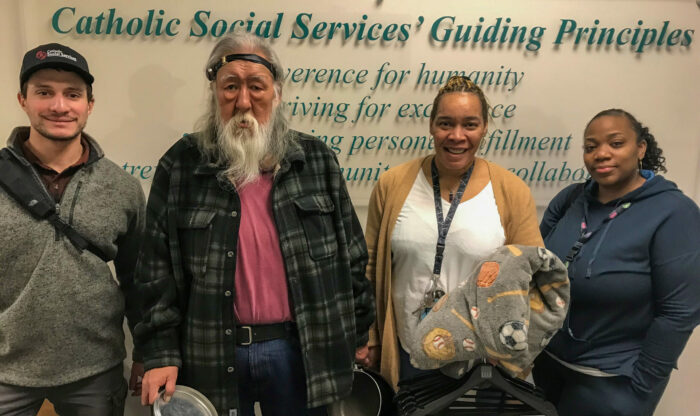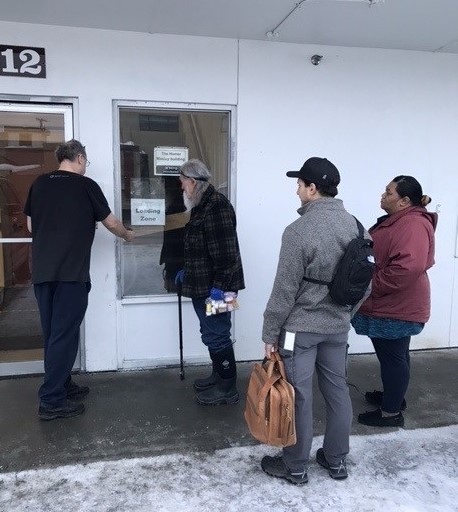
Contributed by Michael Hollinger, Case Manager at Brother Francis Shelter
“I know all these mountains just by looking at them,” my client tells me as we drive to see a potential apartment through Cook Inlet Housing Authority (CIHA). “Where to make shelter. Where to survive.”
I enjoy listening to him share about growing up in a remote, Alaskan village. Now a senior citizen of our community, his life experiences traverse both old and new. “You know, I could walk all the way to my village from right here in Anchorage. By myself with no problem.” After having listened to his hunting stories, I believe him. He also has a reputation at our shelters for being quite nimble and quick despite his age. Hopefully, we can find a housing situation for him quickly…as well as nimbly.
Serving those experiencing homelessness in Anchorage is no easy task. With a vacancy rate of 2-3%, the market is already tight. Compound that existing situation with steep income requirements, credit checks, references, criminal background searches, and apartment specific requirements, finding a suitable apartment can be rather challenging. To help ameliorate the odds, CIHA launched a grant-funded Rapid Rehousing Program (RRH). Rapid Rehousing is essentially a Housing First model that provides financial resources and services to give individuals a critical boost out of homelessness. Through CIHA’s RRH grant, I connected with this particular client and the journey began.
Confidently, we set out to navigate Anchorage’s rather tumultuous, housing landscape. We searched here and applied there. Spoke with these representatives and left messages with those. A number of times we visited various offices – Social Security, Vital Statistics, Adult Public Assistance – in order to piece together the necessary documentation as well as the necessary trail of his benefit history.
The whole way, my client approached every twist and turn with jovial poise. During this process, the CIHA grant, which he received funding under, came to an end. Nevertheless, we were able to connect him with another grant we had available which also included case management services for up to a year. This illustrates the importance of having a range of effective grants in our arsenal. When circumstances change in one area, the solution may continue in another. Stabilization comes through a network of partners. However, no good story is without its predicament.
Right as we thought we were nearing approval, a significant barrier was uncovered regarding my client’s eligibility, and the application was immediately dropped. Perplexed, I was somewhat offput that this had not come up in conversation before with my client, but then I realized we all have our insecurities and considered my client may not have been comfortable sharing that piece of information with me. Being a case manager requires that we look past our pride and meet our clients where they are at. The search continued.

Coordinating with his shelter-based case manager, we continued calling and applying to various apartments. Finally, we found an apartment and made contact with them. They did not require credit checks, background checks, or income standards. The lease was monthly, and the rent affordable, even once the grant ended. Though the neighboring units were being renovated, they had one available straightaway, and promised our client would be first in line to move into one of the refurbished units. I could barely believe how fast the process was.
After completing the one-page application and receiving acceptance, we scheduled a move-in the following week. At the meeting with the property manager, I mentioned a great resource our community had through the Landlord Housing Partnership (LHP). Though this particular landlord was not within LHP’s network, since they were willing to remove many of the barriers facing our client, the property company was eligible for monetary incentives through LHP. Even with a competitive housing environment, this gives an example of how targeted grant-funded programs, willing landlords, and dedicated community partners, can make tangible differences in our community.
That Monday, my client’s entire shelter-based case management team accompanied him to the move. We transferred all his belongings to his new apartment, coordinated with the team at Saint Francis House Food Pantry for food and household items, made a run to Walmart, and got our client well settled. It was awesome seeing everyone come together to make a difference in the life of one individual.
Thanks to a concerted community effort, my client is able to live in stable, sustainable housing – effectively ending his journey through homelessness. This is a win we can all be proud of.